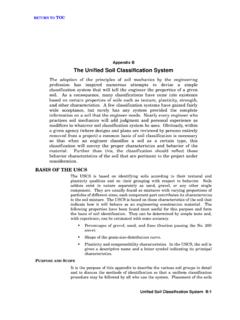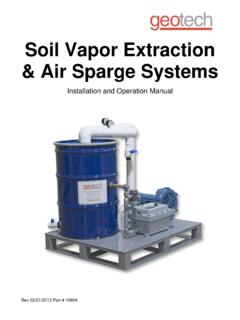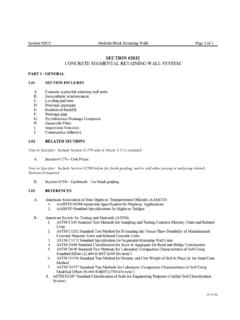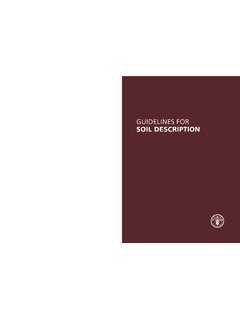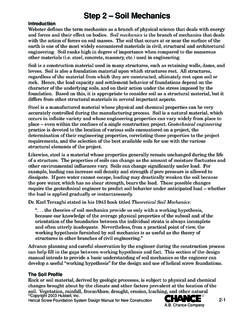Transcription of Classification of Organic Soils - GeoStructures
1 FHWA/IN/JTRP-2008/2 Final Report Classification OF Organic Soils Pao-Tsung Huang Mital Patel Maria Caterina Santagata Antonio Bobet September 2009 Final Report FHWA/IN/JTRP-2008/2 Classification OF Organic Soils by Pao-Tsung Huang Graduate Research Assistant Mital Patel Graduate Research Assistant Maria Caterina Santagata Assistant Professor and Antonio Bobet Associate Professor School of Civil Engineering Purdue University Joint Transportation Research Program Project No. C-36-36TT File No. 6-14-45 SPR-3005 Conducted in Cooperation with the Indiana Department of Transportation and the Department of Transportation Federal Highway Administration The contents of this report reflect the views of the authors who are responsible for the facts and the accuracy of the data presented herein.
2 The contents do not necessarily reflect the official views or policies of the Indiana Department of Transportation or the Federal Highway Administration at the time of publication. This report does not constitute a standard, specification, or regulation. School of Civil Engineering Purdue University September 2009 TECHNICAL REPORT STANDARD TITLE PAGE 1. Report No. 2. Government Accession No. 3. Recipient's Catalog No. FHWA/IN/JTRP-2008/2 4. Title and Subtitle Classification of Organic Soils 5. Report Date September 2009 6. Performing Organization Code 7.
3 Author(s) Pao-Tsung Huang, Mital Patel, Maria Caterina Santagata, and Antonio Bobet 8. Performing Organization Report No. FHWA/IN/JTRP-2008/2 9. Performing Organization Name and Address Joint Transportation Research Program 1284 Civil Engineering Building Purdue University West Lafayette, IN 47907-1284 10. Work Unit No. 11. Contract or Grant No. SPR-3005 12. Sponsoring Agency Name and Address Indiana Department of Transportation State Office Building 100 North Senate Avenue Indianapolis, IN 46204 13. Type of Report and Period Covered Final Report 14.
4 Sponsoring Agency Code 15. Supplementary Notes Prepared in cooperation with the Indiana Department of Transportation and Federal Highway Administration. 16. Abstract The presence of organics in Soils is generally associated with high compressibility, significant secondary compression, often unsatisfactory strength characteristics, and low unit weight. As a result of the above, many state DOTs (Departments of Transportation) in the United States have strict limits on the maximum value of the Organic content (2-7%) that can be present in Soils to be used as subgrades and backfills.
5 The loss on ignition test is the most widely used technique for measuring Organic content. However, especially for low Organic content Soils , this method can lead to significantly overestimate the true Organic content. As a result, certain Soils may be incorrectly classified and erroneously considered unviable for certain applications; in other cases unnecessary costly treatments may be requested, even if not required. These are the issues motivating the research presented in this report, which addressed the Classification of Organic Soils and the quantification of Organic matter in Soils .
6 The research reviewed existing Classification systems for Organic Soils , the effects of Organic matter on the geotechnical properties of Soils , and the methods for determination of Organic content. In addition to the review of the existing literature, this research also included experimental work conducted on natural Soils with varying Organic content, as well as on laboratory prepared ( artificial ) Organic Soils . The experiments performed included loss on ignition tests, Atterberg limits, colorimetric tests, dry combustion tests, thermal analyses, and X-ray diffraction analyses.
7 The work led to propose a system for classifying Organic Soils which is based on the percentage of Organic matter present: Soils with Organic content <3% are termed mineral Soils ; if the Organic content is >3% and < 15%, Soils are classified as mineral Soils with organics; when the Organic content exceeds 15% but is <30%, the term Organic soil is employed. Finally, Soils with Organic content higher than 30% are termed highly Organic Soils or peats. Given the potential errors associated with measuring Organic content using the LOI method, this research proposes an approach based on the combined use of the LOI test, the liquid limit test conducted both before.
8 17. Key Words Organic Soils , Classification , LOI, Atterberg limits, liquid limit ratio, colorimetric test. 18. Distribution Statement No restrictions. This document is available to the public through the National Technical Information Service, Springfield, VA 22161 19. Security Classif. (of this report) Unclassified 20. Security Classif. (of this page) Unclassified 21. No. of Pages 180 22. Price Form DOT F (8-69) i TABLE OF CONTENTS Page TABLE OF LIST OF LIST OF CHAPTER 1: STATEMENT OF ORGANIZATION OF THIS CHAPTER 2.
9 Classification OF CHARACTERISTICS OF soil Organic AGRICULTURAL NRCS Canadian System of soil Australian soil Classification New Zealand soil Classification Russian soil Classification Danish soil Classification The soil Classification System in England and BOTANICAL The Radforth Classification The Modified Von Post Classification ENGINEERING Engineering Classification Systems in the United States ..46 Engineering Classification of the International Organization for Standardization (ISO) ..52 Classification by Indiana Department of Transportation (INDOT).
10 54 OTHER Classification SYSTEMS ..55 Classification Systems Reviewed by Myslinska (2003) ..55 Classification Systems Reviewed by Landva et al. (1980) ..60 ii CHAPTER 3: EFFECTS OF Organic MATTER ON GEOTECHNICAL PROPERTIES OF INDEX Water Gas Bulk Specific Particle Size Atterberg Shrinkage Cation Exchange Capacity and ENGINEERING CHAPTER 4: METHODS FOR DETERMINATION OF Organic DIRECT Loss on Ignition (LOI) Hydrogen Peroxide (H2O2) INDIRECT Dry Combustion Wet Combustion Dichromate Oxidation Methods of Removing Inorganic Comparison of Indirect LIMITATIONS OF LOSS ON IGNITION iii OTHER Colorimetric Thermal CHAPTER 5: EXPERIMENTAL OVERVIEW OF EXPERIMENTAL Soils Test Methods and Loss on ignition test (LOI).
